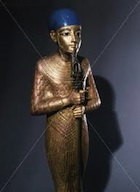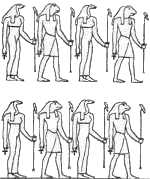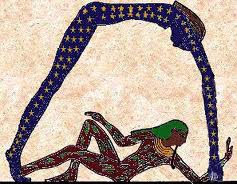III. The Ancient Egyptian Creation Myths
In the final paragraph of The Mind of Egypt Assmann says, “Egyptology rests first on the rejection of the biblical, Greek, Latin and other testimonies about ancient Egyptian culture, whose value as sources was greatly diminished, first, by the discovery of the abundance of Egyptian testimonies and, second, by an interpretative abstinence that had already distinguished the antiquarianism of the sixteenth to eighteenth centuries and was elevated to a principle by the positivism of the nineteenth and twentieth centuries.” We should heed this warning against finding Christian trinities and biblical floods in Egypt and keep interpretation simple, as close as possible to the facts, however meager they may be. “Today we know infinitely more about Egypt than did the experts of the eighteenth century,” Assmann adds. (Unless one is willing to devote one’s life to Egypt, one also knows infinitely less than the Egyptologist.) “But we are also infinitely less sure,” he says, “of what to do with that knowledge.” A useful caveat. One thing to do is to present the evidence, as reliably reported by experts, and let the reader decide.
One such expert is Lucia Gahlin, a respected scholar in the field but also a popular lecturer. Her two pages on the Creation Myths in Egypt: Gods, Myths and Religion, plus her extended commentaries, will be our guide. My own amateurish remarks about what she reports are not authoritative (how could they be from someone who, though he has visited Egypt has not examined the texts in Elephantine, Memphis, Hermopolis Magna or Heliopolis, and, if he had, could not read the hieroglyphs; whose grasp of the pantheon is rudimentary and who, though he has read a bit of Egyptian history, still struggles to keep the names of the Pharaohs straight?). This paragraph is a statement of modesty and a confession of ignorance that applies to what follows, as we turn now to the Creator Gods, to the Triads, the Dyads and the Singular Gods (first among them Amun), to the foundation myth of Isis, Osiris and Horus, and to all other aspects of ancient Egyptian religion, including the Cults, the Temples and the Tombs. Sometimes I think that I should have become an Egyptologist, but unfortunately I did not.
According to Gahlin, “Several explanations as to how the universe came into being survive from ancient Egypt. Each major center of religious belief had its own version of the myth of creation, with a different main creator deity who was self-engendered and who went on to generate the other gods and goddesses before creating mankind.” In Elephantine he was called Khnum; in Memphis, Ptah; in Hermopolis there were eight gods that we call the Ogdoad; in Heliopolis, nine engendered by Atum that we call the Ennead. We note that Gahlin’s principal interpretation here is henotheistic: the self-engendered god goes on to generate the other gods, remaining after them primus inter pares. Geographically the myths were of different origins, though later they were believed in various places — another form of henotheism. “It is impossible to say which myth was the most widely accepted at any one time.” Or which, we might add, was the first, which the second. It is fashionable nowadays to say that they are “all different aspects of the same story,” but I am dubious about any such Egyptian unanimity.

Khnum
I might review these various stories, placing them in an interesting, if not necessarily historical, order so as to reflect what we know generally about how myths develop. On the island of Elephantine, way up the Nile, opposite the town of Aswan (which I have visited), Khnum, the god with a ram’s head and corkscrew horns, was associated with the Inundation. In an early Triad, his wife was Satis, a fertility goddess, their daughter, Anuket, a warrior goddess who had earlier been regarded as the daughter of Ra, the sun god. Like the Hebrew Jehovah, who modeled Adam (= clay) from the earth, Khnum “created the universe by modeling the other gods, as well as humankind (both Egyptians and those who spoke other languages), animals, birds, fish, reptiles and plants, out of clay on his potter’s wheel.” Shaw and Nicholson see his cosmogonic role as one of the principal creator gods stemming “inevitably from the combination of the creative symbolism of molding pottery, the traditional potency of the ram and the fact that the Egyptian word for ram, ba, also had the meaning of ‘spiritual essence,’” perhaps of Ra.

Ptah
Just south of Cairo, at Memphis (which means “The House of Ptah”) Ptah, the self-engendered creator god, “was referred to as the ‘father of the gods from whom all life emerged.’” Gahlin continues: “He brought the universe into being by conceiving all aspects of it in his heart, then speaking his thoughts out loud.” Creation as the Conception and Word of the creator we find in the New Testament (John 1:1), but here, in Egypt, Ptah immediately “created the other deities, and then towns with shrines to house them.” Thus he is more a philosophical god or administrative priest than Khnum. He creates by naming. “He provided . . . statues to act as bodies for the divine spirit or power, ka, of the deities, and offerings to be made to them forever.” Ptah later assimilated the fertility god Sokar, the two joining in a Triad with Osiris (with whom Sokar himself had been identified). Like a fertility god(dess), Ptah “ensured the continuation of the human race by watching over conception and labor.” The Greeks saw in him a Hephaistos. In Memphis he shared with Sokar as consort Sekhmet, the lion-goddess.

The Ogdoad
At Hermopolis Magna, a third of the way up the Nile, the creation myth begins not with a creator god but rather with “the elements necessary for the creation to take place,” “arranged in four male-female pairs: primordial water (Nun and Naunet), air (Amun and Amaunet); darkness (Kuk and Kauket); and formlessness or infinity, otherwise interpreted as the flood force (Huh and Hauhet). Thus the singular creator god, Amun, whom we will take up in the next section, is mentioned, but has not yet become singular. The eight gods were called the Ogdoad and took the form of four frog-headed males and four snake-headed females, also suggesting a more primitive version of the Amun myth. The myth had two versions. In one there arose from the primordial waters a mound of earth, the Isle of Flame, upon which Thoth, as an ibis, placed a cosmic egg; it hatched the sun, which ascended into the sky. In the other, a lotus flower (personified as Nefertem) bobbing on the primordial waters, opened its petals and the sun (personified as Horus) arose out of it. In the first, a god intervenes; in the second, the sun is generated by Nature.

Nut above Geb
Just north of Cairo, at Heliopolis, we have the elements found in the monotheistic creation myth of the Hebrews and in the polytheistic pantheons of the Greeks (and the Indians). “Before anything existed or creation had taken place, there was darkness and endless, lifeless water, personified as Nun. A mound of fertile silt emerged from the watery chaos” (as in the Hermopolis myth). “The self-engendered solar creator Atum (‘the All,’ or ‘the Complete One’) appeared upon the mound. By masturbating (or, in another version, sneezing) he was able to spit out Shu (the divine personification of air) and Tefnut (of moisture). Now that a male-female pair existed, they were able to procreate more conventionally.” (Thus we see early Egyptian abstractions becoming anthropomorphized.) “The results of their sexual union were Geb (the earth) and Nut (the sky). These two [as in Greek myth] were forcibly separated, by their father Shu, who lifted Nut up to her place above earth.” In a likely gloss on later theology, the Ennead (or group of nine) emerged, by adding to these five gods, Osiris, Seth, Isis and Nepthys.
Despite the variety of deities involved in these different narratives, however, the Egyptians, we are told, by Wim van den Dungen, in his Internet presentation, “conceived the origin of the world as singular. Only one god (Atum) was responsible for the emergence of the universe as a bubble of air in the vast, limitless, inert ocean and everlasting darkness of the undifferentiated primordial waters (Nun) that existed before creation. Even after creation these waters continued to exist, for they surrounded creation in all directions and were characterized as ‘an infinite flood.’” Egyptologists such as Hornung and Allen have compared the schematics of the interrelated Egyptian deities with our laws of modern physics. (“Both try to explain what the world is like and why it behaves the way it does.”) In the historical development of monotheism, moveover, we may see the same yearning as in the physicist’s search for a unified field theory or in his efforts to reconcile Newton, Einstein, quantum mechanics and superstring (or M) theory. Likewise the mythographer who seeks a unity among the diversity of the creation accounts.
In the Old Kingdom the dominant view was developed by the priests of Heliopolis and is therefore called the Heliopolitan creation account. It focused on the actual process of creation. Whether this is earlier or later than the other, more mythological, narratives is not known. It is, at any rate, says Wim van den Dungen, “essential to understand that the Egyptians did not adhere to a Biblical creation ex nihilo (“out of nothing”) but to the doctrine ex nihilo nihil fit (“out of nothing nothing comes”). Everything emerged [in the generalized myth to which the creation accounts are tending] from a primordial, active singularity called ‘Atum’ or ‘finisher.’ He is also called ‘Lord of All’ and ‘Lord to the Limit.’ But before Atum ‘evolved himself,’ he pre-existed within the primordial waters in a state of inert potentiality. He was alone with Nun, but “in his egg Atum,” he explains, “is Nun turned active (while Nun’s inertia remains). Nun is Atum dormant (while Atum’s potentiality remains). Both are ‘father of the gods.’ Diversity evolved from a single source.” Thus several states in the emergence of the deities are obvious:
Inert potentiality (in the following notes I modify quotations from Wim van den Dungen)
- Nun has a continual existence unaffected by mythology or events and plays no part in religious ceremonies, has no temples or priesthood.
- He is not subject to cosmic order (Maat), and his waters were considered beneficial for ablution and rejuvenation (in the Sacred Lake).
- In a Hymn to Khnum, humanity and the gods feast on the fishes of Nun. Atum existed in this primordial state as the dormant potential to create.
Active aloneness
- Atum subsequently evolved from such an inert potentiality (broke out of his shell) into a singular (except for Nun) source of all creation.
- His solitary act of self-creation initiated the generation of the deities.
The time of the gods
- Atum’s first act of creation is his “splitting into two complementary forces (he himself seen as bisexual or androgynous)”:
- His son Shu, a dry and empty space in the midst of the waters (the principle of life) and his daughter Tefnut (moisture and the principle of order).
- This void within the waters produced a bottom (Earth, Geb) and a top (Heaven, Nut). Together they represent the physical structure and limits of the created world.
- It produced a place within which life could exist: Osiris, Seth, Isis and Nepthys.
- The Ennead represents the sum of all the elements and forces of the created world.
The time of the world
- The created order (Maat) in general and the unity of the Two Lands in particular. The birth of the Sun was the culmination of this generation, marking the end of creation and the beginning of the eternal cycle of life, which the Sun, as king of Nature, regulated and made possible through heat and light.
- Re is the culmination of Atum’s “evolution,” the two syncretized in Re-Atum.
- The development of the fundamental myths called hundreds of deities into being, each representing the elements and forces and “explaining” the recognized activities at hand.
- The phrase “Atum and his Ennead” implies Pharaoh Horus and the power of kingship. Indeed, in creation Pharaoh was the central figure, for he was a god alive on Earth.
-
Although the evolution of Atum is explained in generational terms, creation in fact happened all at once, namely, in the supreme moment when Atum evolved into the world (broke out of the egg) and time and space began. [Cp. The timeless reality preceding the creation of time and space in the contemporary physicist’s cosmogony.]
Despite these generalizations, however, there is “in the whole of Ancient Egyptian literature, no theory, no definition, no abstract, discursive activity to be found.”
Such an atomistic polytheism was not, moreover, the theology chosen by the Heliopolitan priests of the 4th Dynasty. Indeed, it is likely that already in Predynastic Egypt an underlying unity had been conceived of (cf. the role of the Great Goddess of the Sky). Although Atum was the sole Lord of All (without a second, and alone in the act of creating himself), his self-creation was simultaneous with the coming into being of Shu and Tefnut (cf. the myth of the Single Eye, sent out because Atum had become weary by being too alone). A notion like the Aten (the solitary physical disc of the Sun as the only god worthy of veneration, a doctrine promulgated by Amenhotep IV (Akhenaten) at el-Amarna (which he renamed Akhetaten, Horizon of the Aten) was rejected by the Egyptian mind as heretical and blasphemous. God could be anywhere and remain hidden. Egyptian syncretism and belief in one universal deity did not, however, initiate a movement towards the centrality and numerical exclusivity of monotheism. Divine unity was considered a matter of precreation, and the act of creation, but not of creation itself.